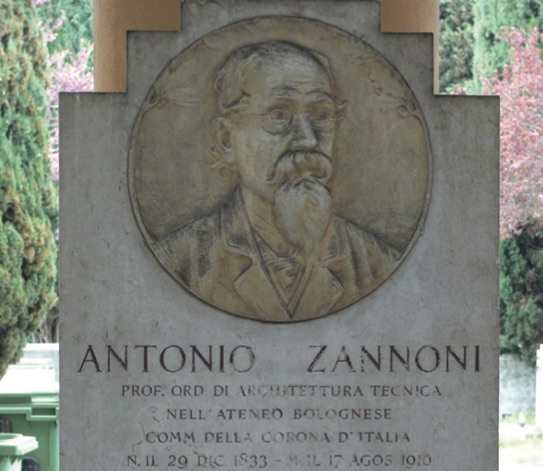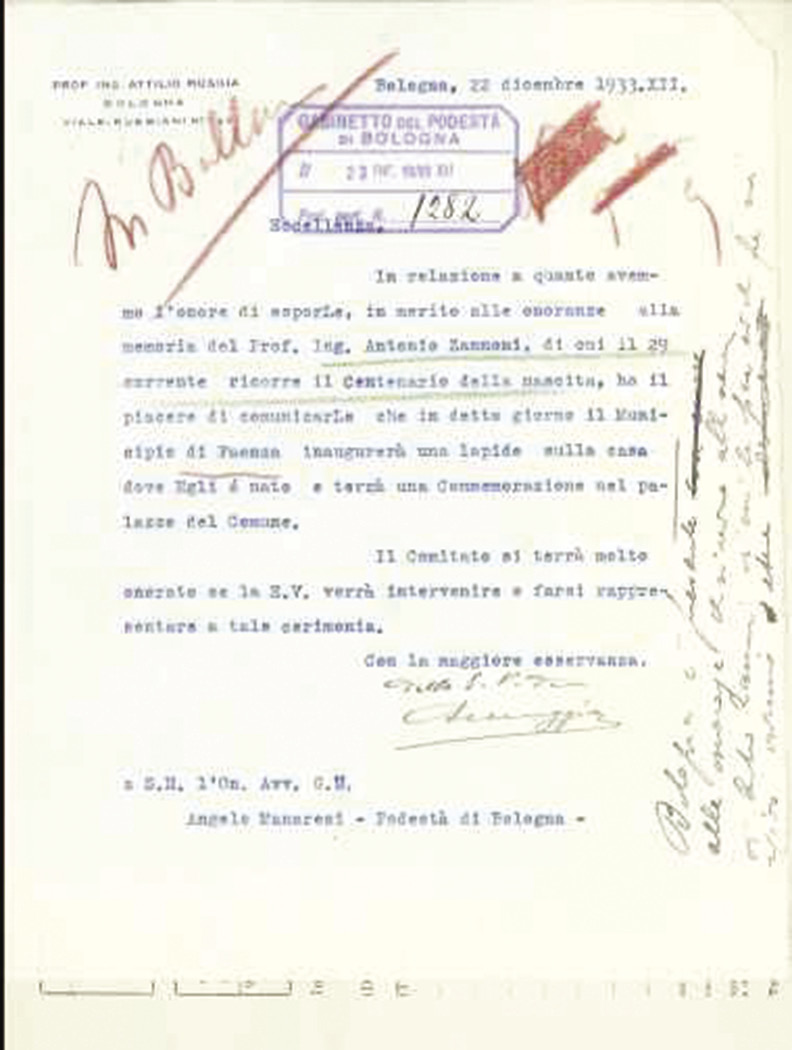Antonio Zannoni was born in Faenza on December 29, 1833. In 1859, he graduated from the University of Rome in philosophy and mathematics and moved to Bologna where he obtained, in 1861, the title of engineer and architect from the technical school for engineers Regia Scuola di applicazione degli Ingegneri. In April of the same year, Coriolano Monti, head of the Technical Office of the Municipality of Bologna, recommended him as first assistant, on a provisional basis, for 125 lire a month for as long as he was in service. The appointment was formalized by the council on April 27, 1861, in what appeared to be a reorganization of the offices of the aedileship and art. The collaboration with Coriolano Monti was undoubtedly close, and it is significant that already in October of the same year Zannoni took over Monti's representation in his absence, to ensure that the work in progress was not delayed and a cause of prejudice to the municipality. Zannoni's achievements include archaeological discoveries, the reopening of the ancient Roman aqueduct, the design of the direct railway between Bologna and Florence, numerous architectural projects and his work as a professor of algebra and geometry.
In 1861, during some building work, a section of the ancient Roman aqueduct was found in the centre of the town. Zannoni took a special interest in the matter in order to trace the original route of the conduit built in the Augustan age, which had long since fallen into disuse and whose traces had been lost. His studies led to the conviction that a modern aqueduct could be built, providing the city with drinking water for urban hygiene, a problem that was very acute at the time. The cholera epidemic of 1865 encouraged the administration to continue with the reactivation project, which was completed on June 5, 1881, when water from the ancient Roman aqueduct flowed from Val di Setta back to the town.

Among Zannoni's achievements, we must not overlook his role as an archaeologist when he supervised the work of the Certosa cemetery. On August 23, 1869, a bronze Etruscan tomb with a cist containing burnt bones and funerary objects was discovered in the cloister of the Madonnas.
Zannoni realized that the discovery was part of a vast necropolis. He obtained the authorization and the means to proceed with the excavations that continued exploring the Campo degli Spedali. It was the beginning of a passion for archaeology which persisted over time. In the following years, he made many other discoveries, from the western Etruscan burial grounds of Felsina, to the settlement of sheds found in the current historical city centre where the foundry repository of Piazza San Francesco was found, following an intuition and realizing a program already outlined during the excavations of the Certosa.
Antonio Zannoni would succeed Coriolano Monti as chief engineer of the Technical Office from 1874 to 1877. Among his numerous works, the completion of the Legnani Pizzardi Palace is worth mentioning; the Zappoli and Pierantoni palaces on Via Indipendenza; the Ratta and Bottrigari palaces of Piazza Cavour; the Gallery of Angels at the Cemetery of Certosa; the Pallavicini palace on Via Galliera; the Civic Archaeological Museum; the alteration of the Ranuzzi-Baciocchi palace into the new headquarters of the judicial authorities; the old post office in the town hall, later the Treasury of Bologna's Cassa di Risparmio, and the Vitta house outside of Porta Santo Stefano. Zannoni was responsible for the definition of the route of the Bologna-Florence direct railway, proposed in 1882 (Proposte e studi, Regia Tipografia) and in 1888 (Progetto dettagliato, published by Azzoguidi). The new railway line, which became a national public work with the law of 1908, was inaugurated on April 22, 1934, and reduced the Bologna-Florence route from 132 to just over 97 kilometres cutting by two hours the travelling time between the two cities. Antonio Zannoni was a professor committed to the advancement of technical and vocational education. For almost twelve years, he taught the principles of geometry and architecture to workers and craftsmen in the municipal evening school of the arts of builders, which he founded in Bologna. In 1883 he became a professor of technical architecture and taught at the School of Engineering in Bologna. In 1892, he was appointed extraordinary professor of engineering and, in 1899, he became full professor. An extraordinary figure of a scholar at the service of the city in various fields of scientific knowledge, Antonio Zannoni contributed in a decisive way to the cultural, social and civil development of post-unification Bologna. He died in Ceretolo di Casalecchio di Reno, on August 17, 1910. In 1928, the Municipality of Bologna dedicated a street to him, from Via Andrea Costa to Via Fernando de Rosa, in the Saragozza area.





.png)